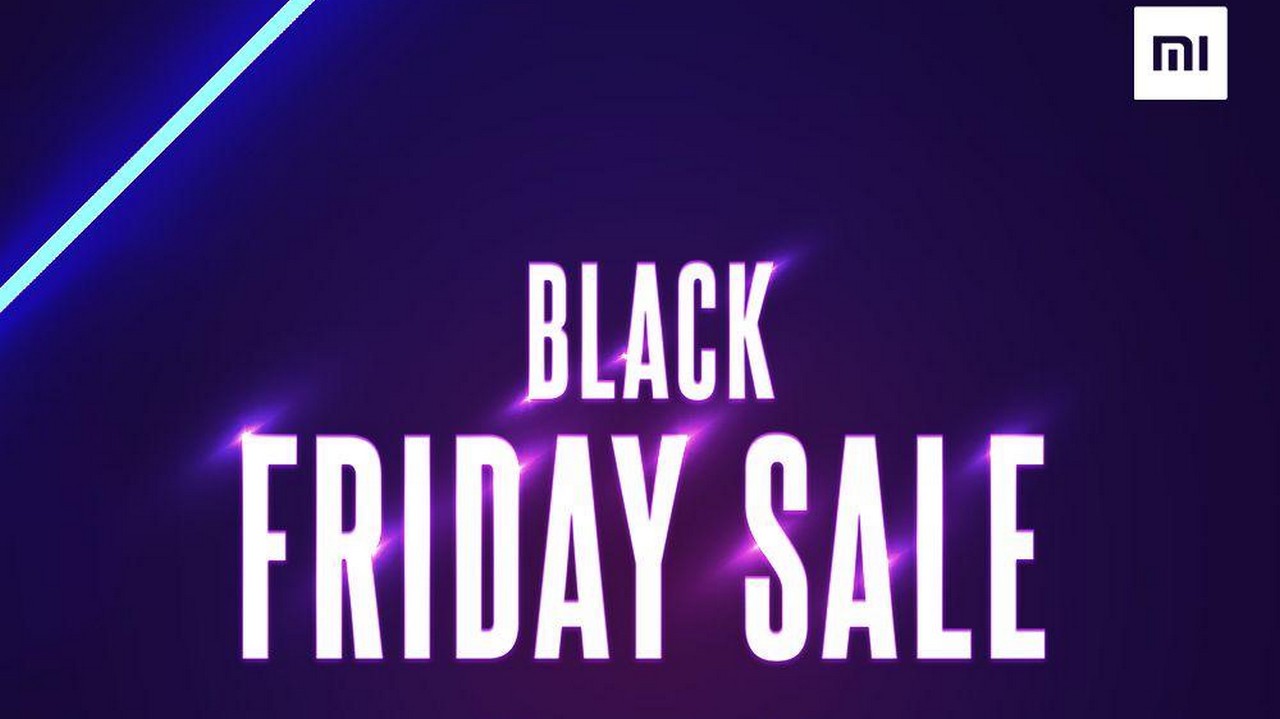Ameya DalviNov 28, 2020 17:32:47 IST
Rating: 4/5
Price: Rs 3,999
Over the past 12 to 14 months, we have reviewed a handful of Amazfit’s more premium watches, ranging from Amazfit GTR to the T-Rex, catering to different segments of buyers. We quite liked what they brought to the table. Today, we have their latest budget offering, the Amazfit Bip U that skips some of the higher-end features like a built-in GPS and OLED display, but includes enough useful features at half to a third of the selling price of its more illustrious siblings.
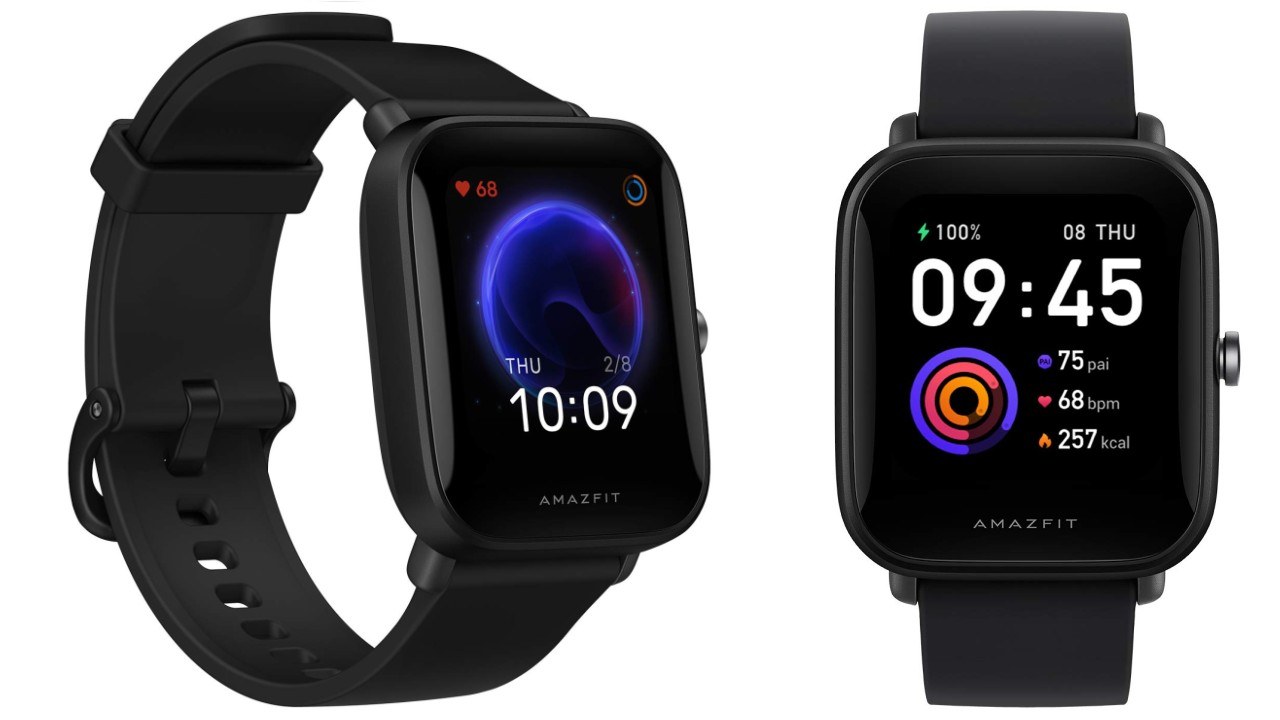
Amazfit Bip U. Image: Amazfit
Standard design but comfortable to wear
The design is fairly standard, with a rectangular face and a solitary button on the right. It looks quite similar to the Amazfit GTS and like every third smartwatch/fitness watch in the country, the design draws inspiration from Apple’s smartwatch lineup. Though the body is made of plastic, it doesn’t feel low quality, and the build is quite solid. The plastic construction does help in keeping the weight down to just 31 grams. The Amazfit Bip U is extremely comfortable to wear for long hours, and the silicone straps don’t cause skin irritation even after prolonged use.
The touchscreen display lets you browse through the menus and access different functions of this device in conjunction with the aforementioned physical button placed along the right edge. The screen turns off automatically after a few seconds (or as per the duration you set from the settings). Alternately, you can just cover it with your palm for a second to turn it off. The watch interface is user-friendly and easy to use even for a novice user. More on that a little later.
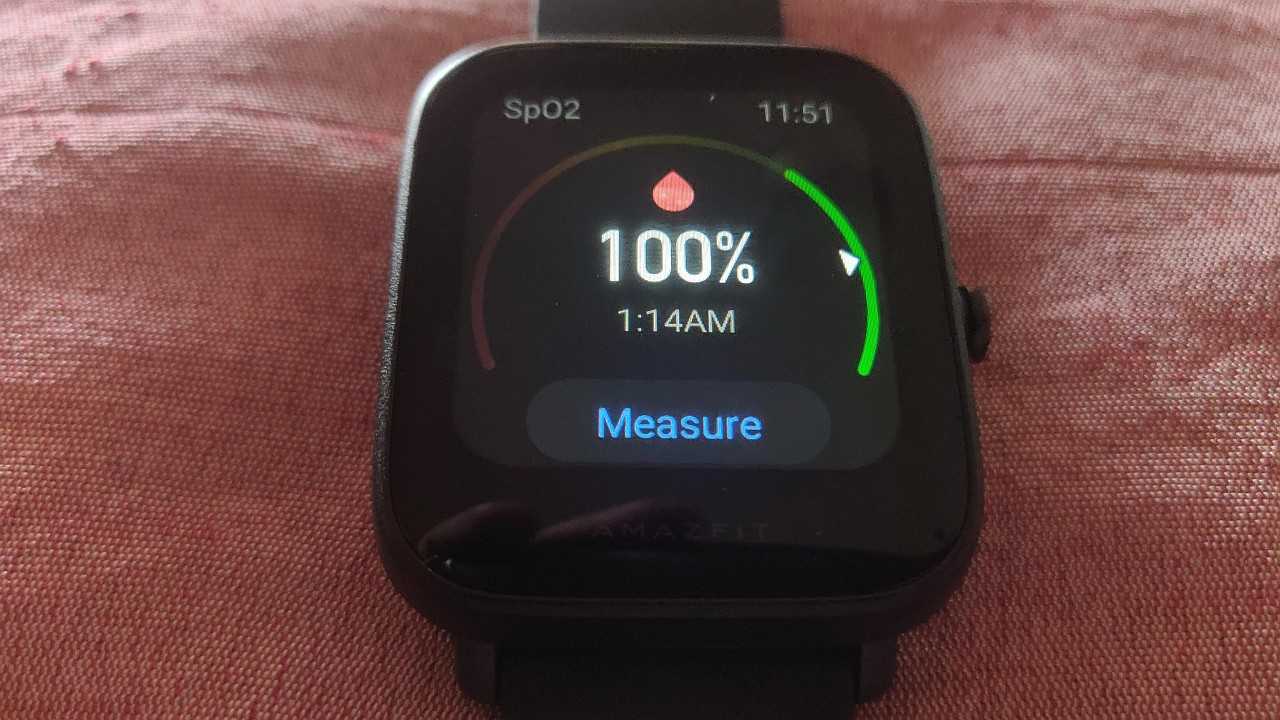
Oximeter on the Amazfit Bip U. Image Credit: Ameya Dalvi
Sharp display with a wide variety of watch faces
The Amazfit Bip U has a sharp 1.43-inch TFT LCD display with a resolution of 320 x 302 pixels. It is protected by a layer of 2.5D scratch-resistant glass that also has an anti-fingerprint coating that works very well. I could barely spot any fingerprints or smudges on the screen during the course of my testing. The screen has manual brightness controls and is perfectly legible outdoors, even even at 50% brightness; when indoors, even 25% brightness is good enough.
You need to flick your wrist to turn the screen on. If that doesn’t work, you can always press the button. There is a DND mode that lets you disable the motion-sensitive screen-on function whenever you wish to, or between 10pm to 8am. If you choose to wear it to sleep and do not activate the DND feature, the Bip U automatically keeps the screen off when it senses that you have fallen asleep. The watch comes preloaded with four watch faces, two of which can be customised to display a variety of information of your choice such as a step count, calories burned, heart rate, battery status and more. The other two faces can be replaced with any of the 50-odd faces available for this watch, ranging from analog to digital, from retro to funky.
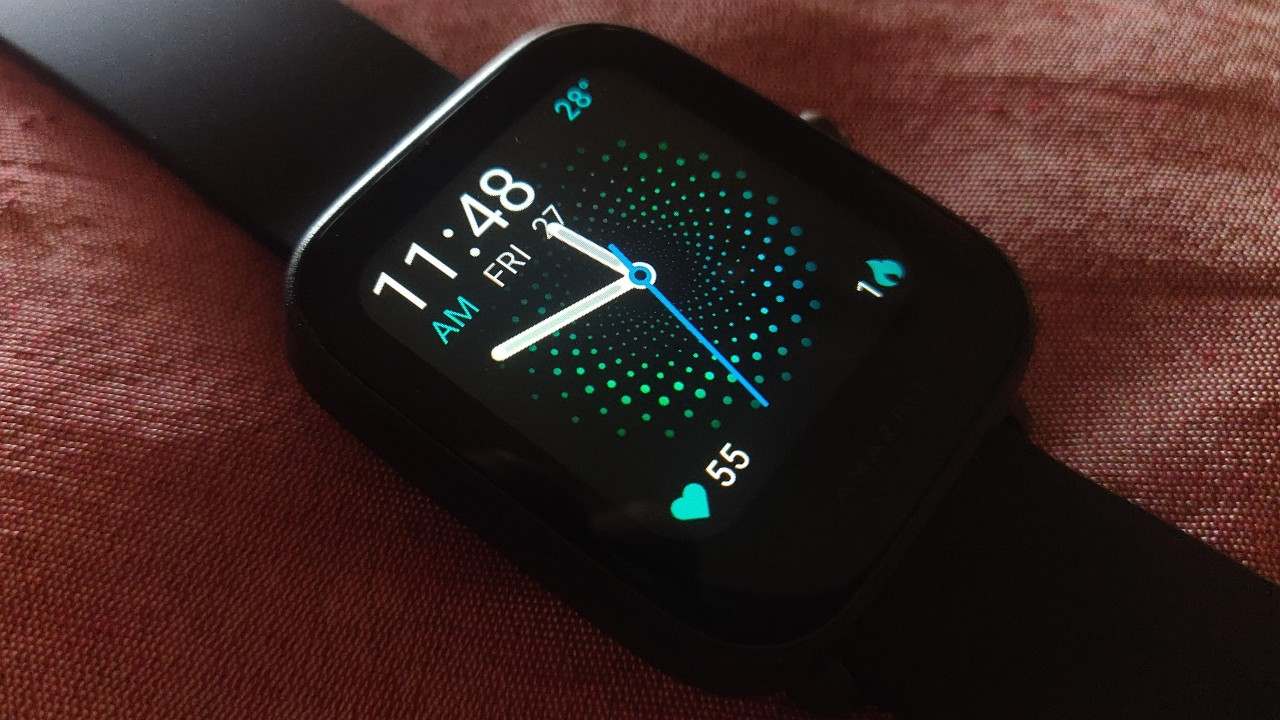
Watch face. Image Credit: Ameya Dalvi
At any point, you can have a maximum of four watch faces stored on the watch. None of the faces that you load on the watch from the app can be customised, something I did not like. Though you have a lot of options to choose from, some could have been designed better. Some faces display a lot of information, but the font size is too tiny, while others may not have the exact parameters you want to see on the watch’s home screen; something for the company to work on.
Simple and smart user interface
As with all Amazfit watches, you need to download the Amazfit app (now called Zepp), add your device in there and sync it over Bluetooth. It takes a while initially, but once it’s set up, things work smoothly. It does take longer than usual to transfer stuff to the watchm such as a new firmware update or even a watch face. I have complained in the past about the over-reliance of Amazfit watches on the app for accessing a majority of its features, but that’s not the case here. The Bip U lets you control several functions from the watch screen itself, leaving just a few for the app, which is great to see.
You need the app mainly to select a different watch face, set your fitness goals, track your progress, crunch data captured by the watch and present it to you in a neat manner. You get alerts on the watch screen when you reach your fitness goals for the day or for incoming calls and messages. The watch UI is very simple. All you need to do is swipe down on the screen for settings and swipe up to access notifications. Swipe left or right to browse through activities, daily goal progress and other options such as heart rate, blood oxygen level, music control, weather or any options that you choose as app shortcuts.
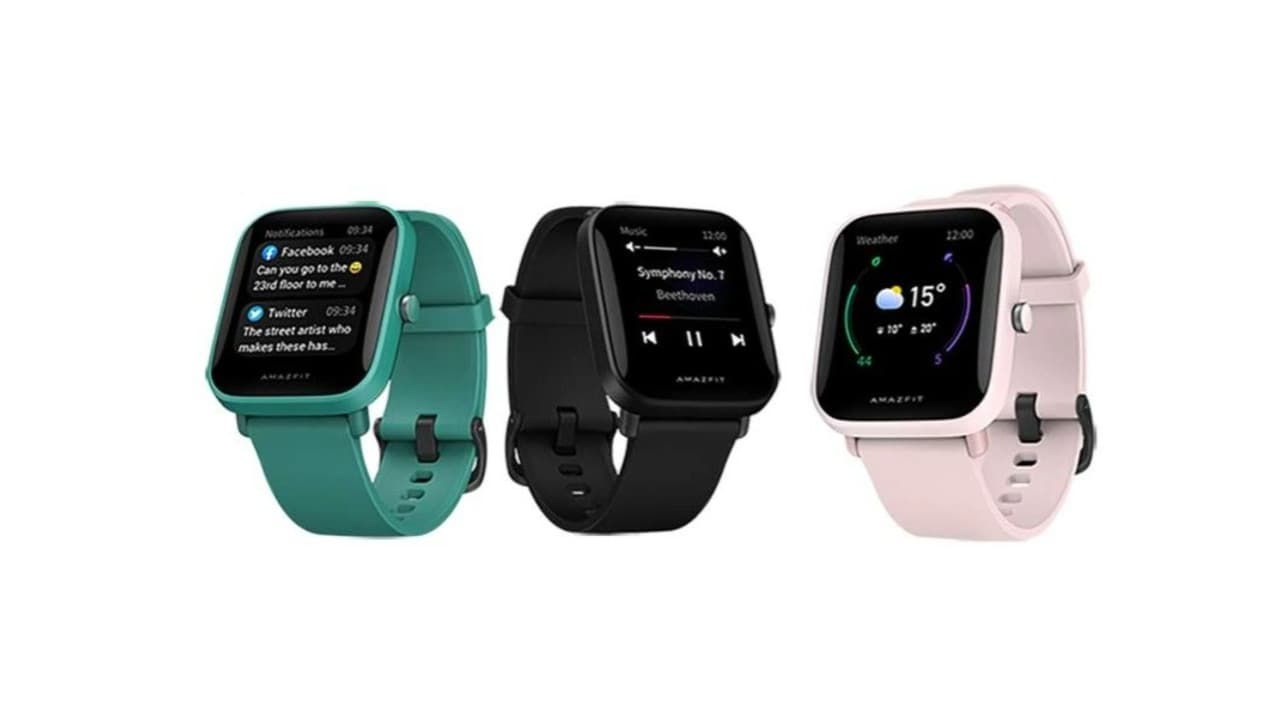
Amazfit Bip U in all available colors. Image: Amazfit
Most functions come with short explanations (on the watch screen itself) of what they are supposed to do, which is a good addition. The rest of the functions such as sleep and stress data, choice of workout, alarm and such can be accessed by pressing the physical button. The same button can be used to go back in the menu. The UI is smartly designed, completely stutter-free and very easy to get used to.
Handful of useful features, surprisingly good performance for the segment
Before we move on to the health and fitness features, let me quickly touch upon other useful things the Amazfit Bip U can handle. The watch lets you answer or silence incoming calls from the watch screen. You can also reject a call and reply with a preset SMS from there, if you enable this in the companion app. SMS can also be read on the watch screen, and the font is sufficiently large. You cannot, however, reply from the watch. You can opt to receive notifications from other apps too, along with event reminders and weather updates. You cannot install any new apps on this device, and have to make do with what’s built into the watch.
As a fitness tracker, there are a handful of useful options. It can track dozens of different kinds of exercises – indoor and outdoor – from walking, running, cycling, swimming, weight training skipping and more, along with close to 60 different sports modes that include badminton and cricket too. The Bip U is water resistant up to 50 metres, so feel free to wear it into the swimming pool without worry (post-pandemic, of course). The watch doesn’t have built-in GPS but can make use of the phone GPS in certain cases. The step counter is fairly accurate most of the time. It occasionally errs on the conservative side, but didn’t report false steps during the course of my testing.

Steps and sleep data in app. Image: Screengrab from Amazfit/Ameya Dalvi
The watch claims to support continuous heart rate monitoring, but the best frequency you can set is 1 minute. You can also change the frequency of monitoring to 5, 10 or 30 minutes to conserve battery life. It’s best to turn on ‘Active heart rate monitoring’ in the app. When the watch detects some physical activity, it automatically increases the monitoring frequency for more accurate results. After you are done with the workout, the frequency drops again to save battery. All the fitness data is available in the app and it presents you with a daily, weekly and monthly breakdown of various fitness activities you indulged in during that period.
There’s a sleep tracking feature to analyse your sleeping habits. I personally do not like wearing a watch to bed, but I did so for a few nights to test this feature. It gets the overall sleep duration pretty much spot-on from the time you actually fall asleep, and not just hit the bed. It tracks the quantum of light sleep, deep sleep and awake time. Interestingly, REM sleep information is also available here; it was missing in the more expensive Amazfit watches when I had reviewed them.
You also have an option to measure your stress levels manually, or set the watch to all-day monitoring. Stress is calculated on the basis of the wearer’s heart rate variability. The watch also provides breathing guidance to help you relax and balance your stress levels. Ladies will appreciate the menstrual cycle tracking functionality in this watch.
The Amazfit Bip U includes a very useful feature for current times – a SpO2 sensor, or a pulse oximeter. It measures the level of oxygen saturation in the blood. The readings are as accurate as a basic over-the-counter oximeter you can buy these days. However, you need a rock-steady hand, a good amount of patience and 30 seconds minimum to get there. To get accurate results in about half a minute, you have to rest your hand on a flat surface with the watch screen pointing upwards, and stay absolutely steady. Best to take a couple of readings to be doubly sure. Nonetheless, a more than useful feature to have.
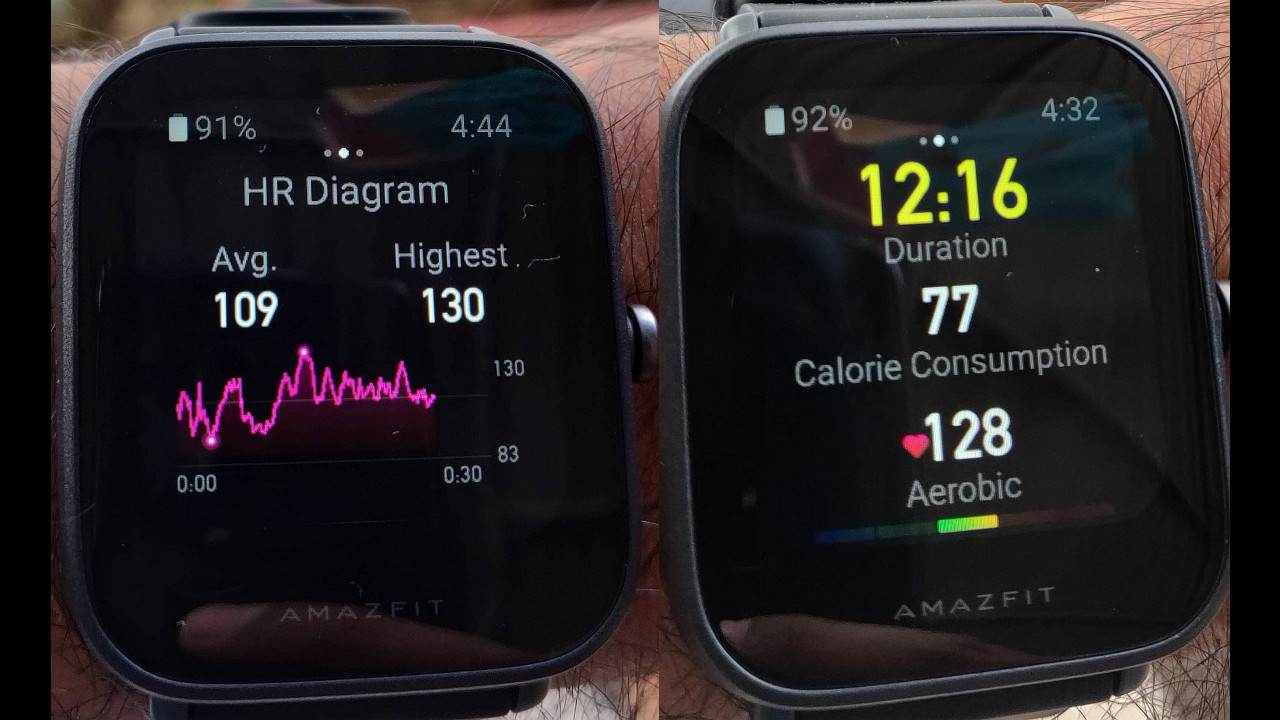
Workout readings. Image: Ameya Dalvi
Decent battery life, but Amazfit has spoiled us with better
One thing you can expect from Amazfit watches is excellent battery life. The Amazfit Bip U scores reasonably well in this department, but the figures aren’t as impressive as the GTR or the GTS models. The company claims a battery life of 9 days on a single charge under test conditions that are defined as ‘automatic heart rate measurement feature enabled for 10 minutes, Activate on Raise feature is enabled, and other settings are kept in default states. Each day involves the following operations: 50 notifications are received and displayed, 200 screen activations on raise are conducted, outdoor running every other day for 30 minutes and SpO2 measurement twice per day’.
In real-world testing with conditions somewhat similar to those above but with heart rate measurement frequency set to 1 minute, sleep monitoring for three nights and a few extra SpO2 measurements daily, the battery lasted a shade under 6 days on a full charge. Without sleep tracking or with heart rate frequency set to 5 minutes, it can last a full week. Yes, it is nowhere close to the 3 to 4 weeks that I managed to get out of the Amazfit GTS and GTR respectively, but having to charge your watch once a week in this price category is a pretty decent result in itself. The watch’s 230 mAh Lithium-ion polymer battery takes about 2 hours to charge fully with the bundled 2-pin POGO pin charger that attaches itself to the base of the watch magnetically.
Price and verdict
The Amazfit Bip U sells for Rs 3,999 in India with a one year warranty. At that price point, I’m inclined to focus on what the watch offers than what it doesn’t. You get a no-nonsense, feature-rich fitness watch with a sharp display, 50-metre water resistance, dozens of fitness tracking modes, SpO2 sensor and a decent battery life, among other things. It is a big upgrade over budget fitness bands in terms of performance and features, for a very small premium. Its simplicity and ease of use makes the Amazfit Bip U quite likeable, and easy to recommend.






